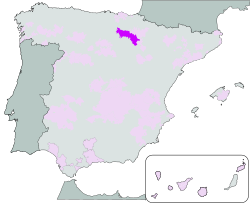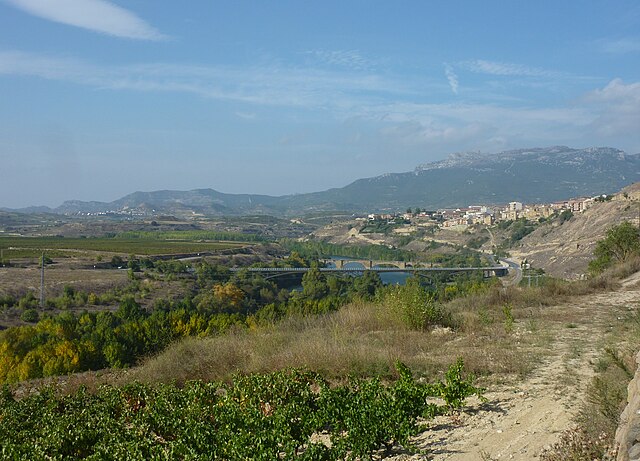Rioja DOCa
Spanish wine region From Wikipedia, the free encyclopedia
Spanish wine region From Wikipedia, the free encyclopedia
Rioja (pronounced [ˈrjoxa]) is a wine region in Spain, with denominación de origen calificada (D.O.Ca., "Qualified Designation of Origin," the highest category in Spanish wine regulation). Rioja wine is made from grapes grown in the autonomous communities of La Rioja and Navarre, and the Basque province of Álava. Rioja is further subdivided into three zones: Rioja Alta, Rioja Oriental and Rioja Alavesa. Many wines have traditionally blended fruit from all three regions, though there is a slow growth in single-zone wines.
| Wine region | |
 | |
| Official name | Denominación de Origen Calificada Rioja / Denominación de Origen Protegida Rioja[1] |
|---|---|
| Type | Denominación de Origen Calificada |
| Country | Spain |
| Sub-regions | Rioja Alta Rioja Oriental Rioja Alavesa |
| Size of planted vineyards | 65,326 hectares (161,424 acres) |
| No. of vineyards | 16,413 |
| Varietals produced | Tempranillo, Viura, Garnacha, Graciano, Mazuelo |
| No. of wineries | 673[2] |
| Wine produced | 3,173,106 hectolitres |
| Comments | Data for 2016 / 2017 |



Located on the western edge of the region and at higher elevations than the other areas, the Rioja Alta is known more for its "old world" style of wine. A higher elevation equates to a shorter growing season, which in turn produces brighter fruit flavors and a wine that is lighter on the palate.[3]
The region of Rioja Alavesa is in the province of Álava in the Basque Country, on the northern bank of the River Ebro. Despite sharing a similar climate as the Alta region, the Rioja Alavesa produces wines with a fuller body and higher acidity.[3] Vineyards in the area have a low vine density with large spacing between rows. This is due to the relatively poor conditions of the soil with the vines needing more distance from each other and less competition for the nutrients in the surrounding soil.[4]
Unlike the more continental climate of the Alta and Alavesa, the Rioja Oriental is strongly influenced by a Mediterranean climate which makes this area the warmest and driest of the Rioja. In the summer months, drought can be a significant viticultural hazard, though since the late 1990s irrigation has been permitted. Temperatures in the summer typically reach 35 °C (95 °F).[4] A number of the vineyards are actually located in nearby Navarra but the wine produced from those grapes belongs to the Rioja appellation. Unlike the typically pale Rioja wine, Oriental wines are very deeply coloured and can be highly alcoholic. They typically do not have much acidity or aroma and are generally used as blending components with wines from other parts of the Rioja.[3]

The traditional varieties authorized by the Regulating Council of the D.O.Ca. Rioja since its foundation in 1925 have been seven, four red and three white:
In 2007, the Regulating Council of the D.O.Ca. Rioja authorized, for the first time since 1925, the incorporation of some additional varieties within the limits of the denomination, changes that were reflected in two modifications of the existing Regulation approved in 2004: BOE-A-2008-4991 and BOE -A-2009-8950, but this has been subject to subsequent amendment.[5]
The currently permitted additional varieties are the following:
These new authorized varieties can only be planted in substitution, so as not to increase the vegetable mass of the Denomination.
In the case of the new autochthonous varieties, both red and white, no limit is set on the percentage that the wines must carry, which is why the production of single varietal wines of these grapes is allowed. On the contrary, in the foreign white varieties (Chardonnay, Sauvignon blanc and Verdejo) it is established that they can not be the predominant ones in the final composition of the wine. Therefore, if the varieties are indicated on the label, the autochthonous white variety (Viura, Garnacha blanca, Malvasía de Rioja, Maturana blanca, Tempranillo blanco or Turruntés) must always be listed first.
The incorporation of these new varieties was made with the aim of recovering Rioja's viticultural heritage, in the case of autochthonous grapes, and to increase the competitiveness of Rioja whites in the international market, in the case of foreign white varieties.
The area cultivated in 2018, in hectares, according to the grape varieties and by Autonomous Communities is as follows:
| Varieties | La Rioja | Álava | Navarra | Total of varieties by Autonomous Communities |
|---|---|---|---|---|
| Tempranillo | 35,058.15 | 11,895.18 | 5,489.51 | 52,442.83 |
| Garnacha | 3,984.03 | 101.06 | 449.30 | 4,534.39 |
| Mazuelo | 889.62 | 97.26 | 253.39 | 1,240.27 |
| Graciano | 820.08 | 167.68 | 297.03 | 1,284.80 |
| Maturana tinta | 140.78 | 22.29 | 18.51 | 181.58 |
| Others Red | 78.56 | 33.77 | 22.37 | 134.70 |
| Total Red | 40,971.22 | 12,317.24 | 6,530.11 | 59,818.57 |
| Viura | 3,139.06 | 824.86 | 201.63 | 4,165.55 |
| Malvasía | 101.82 | 21.29 | 10.66 | 133.76 |
| Garnacha blanca | 156.67 | 7.82 | 53.10 | 217.60 |
| Tempranillo blanco | 602.75 | 32.03 | 116.52 | 751.30 |
| Maturana blanca | 33.84 | 0.22 | 0.99 | 35.06 |
| Verdejo | 207.37 | 2.07 | 118.07 | 327.51 |
| Turruntés | 5.08 | 0.01 | 0 | 5.09 |
| Chardonnay | 112.03 | 6.16 | 31.98 | 150.18 |
| Sauvignon Blanc | 161.84 | 16.03 | 21.74 | 199.60 |
| Other Whites | 34.75 | 1.12 | 0.69 | 36.56 |
| Total White | 4,555.22 | 911.60 | 555.39 | 6,022.21 |
| Total Varieties | 45,526.43 | 13,228.83 | 7,085.50 | 65,840.77 |
As can be seen, red grapes represent 90.85% and white grapes represent 9.15%.
The red grapes are distributed as follows: Tempranillo: 87.67%, Garnacha: 7.58%, Mazuelo: 2.07%, Graciano: 2.15%, Maturana tinta: 0.30% and others: 0.23%.
The percentage among whites is determined as follows: Viura: 69.17%, Malvasia: 2.22%, Garnacha blanca: 3.61%, Tempranillo blanco: 12.48%, Maturana blanca: 0.58%, Verdejo: 5, 44%, Turruntés: 0.08%, Chardonnay: 2.49%, Sauvignon Blanc: 3.31% and others: 0.61%.
The pruning consists in forming the stump with three arms and two thumbs in each arm. Each thumb will have two buds from which the shoots will sprout. The grape harvest is done manually in the month of October. To ensure quality, the quantity is restricted to 6,500 kg / ha for red varieties and 9,000 kg / ha for white.[6]
Traditionally, Rioja wine has been made by assembling different types of grape varieties, although nowadays it is also very common to find monovarietal wines.
In accordance with the Regulation of the D.O.Ca. Rioja (BOE-A-2004-1838410) and its latest modification (BOE-A-2009-895014), the different types of wine must use the authorised varieties in the following proportions:

The aging is carried out in 225-litre oak barrels for a period ranging from 1 to 3 years, and later in the bottle itself for a period of 6 months to 6 years.
Depending on the time the wine remains in the barrel it is classified as:
In 2018, the Regulating Council released new classification rules for Rioja, in an attempt to encourage championship of regional microclimates and put a greater focus on singular vineyard sites.[7] This amended system, similar to Burgundy grading, moves Rioja from being focused primarily on aging and oaking to a more all encompassing system inspecting the terroir of the wine – such as allowing labels to display the village or municipality of origin on the front label.
The harvest ratings of the D.O.Ca. Rioja granted by its Regulating Council since its founding in 1926 are the following:

A distinct characteristic of Rioja wine is the effect of oak aging. First introduced in the early 18th century by Bordeaux influenced winemakers, the use of oak and the pronounced vanilla flavors in the wines has been a virtual trademark of the region though some modern winemakers are experimenting with making wines less influenced by oak. Originally French oak was used but as the cost of the barrels increased many bodegas began to buy American oak planks and fashion them into barrels at Spanish cooperages in a style more closely resembling the French method. This included hand splitting the wood, rather than sawing, and allowing the planks time to dry and "season" in the outdoors versus drying in the kiln.[9] In recent times, more bodegas have begun using French oak again and many will age wines in both American and French oak for blending purposes.[10]
In the past, it was not uncommon for some bodegas to age their red wines for 15–20 years or even more before their release. One notable example of this the Marqués de Murrieta which released its 1942 vintage gran reserva in 1983 after 41 years of aging. Today most bodegas have shifted their winemaking focus to wines that are ready to drink sooner, with the top wines typically aging for 4–8 years prior to release, though some traditionalists still age longer.[9] The typical bodega owns anywhere from 10,000 to 40,000 oak barrels.[11]
The use of oak in white wine has declined significantly in recent times when before the norm was traditionally 2–5 years in oak. This created slightly oxidized wines with flavors of caramel, coffee, and roasted nuts that did not appeal to a large market of consumers with some of the more negative examples showing characteristics of rubber and petrol flavors. Today the focus of white wine makers has been to enhance the vibrancy and fruit flavors of the wine.[11]
Some winemakers utilize a derivative of carbonic maceration in which whole clusters are placed in large open vats and allowed to ferment inside the individual grape berries, without the addition of yeast, for a few days before they are crushed.[3]
In the 1960s, Bodegas Rioja Santiago developed the first bottled version of the wine punch Sangría, based on Rioja wine, and exhibited it at the 1964 New York World's Fair. An import subsidiary of Pepsi Cola purchased the rights to the wine and began marketing it worldwide.[12]
In Spain, wineries are commonly referred to as bodegas though this term may also refer to a wine cellar or warehouse. For quite some time, the Rioja wine industry has been dominated by local family vineyards and co-operatives that have bought the grapes and make the wine. Some bodegas would buy fermented wine from the co-ops and age the wine to sell under their own label. In recent times there has been more emphasis on securing vineyard land and making estate bottled wines from the bodegas.[10]

Like most Spanish wine regions, Rioja is an integral part of Spanish culture and cuisine. In the town of Haro there is an annual Wine Festival that is noted for its Batalla de Vino where participants conduct a food fight of sorts with wine.[13]
Seamless Wikipedia browsing. On steroids.
Every time you click a link to Wikipedia, Wiktionary or Wikiquote in your browser's search results, it will show the modern Wikiwand interface.
Wikiwand extension is a five stars, simple, with minimum permission required to keep your browsing private, safe and transparent.